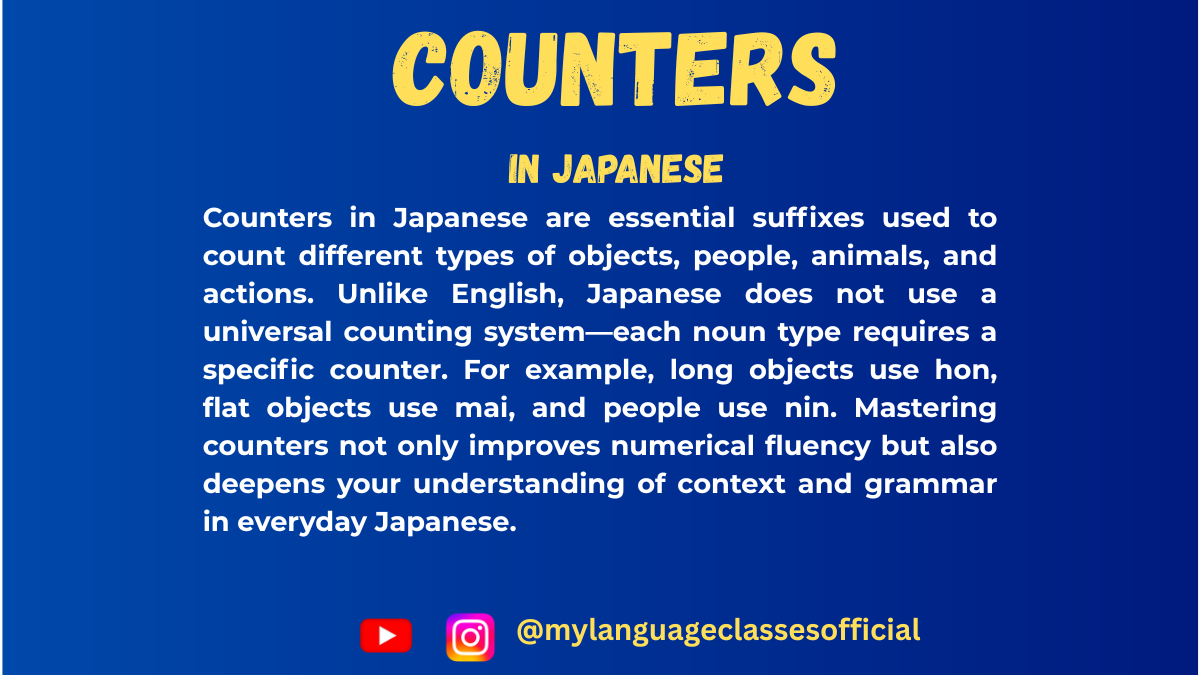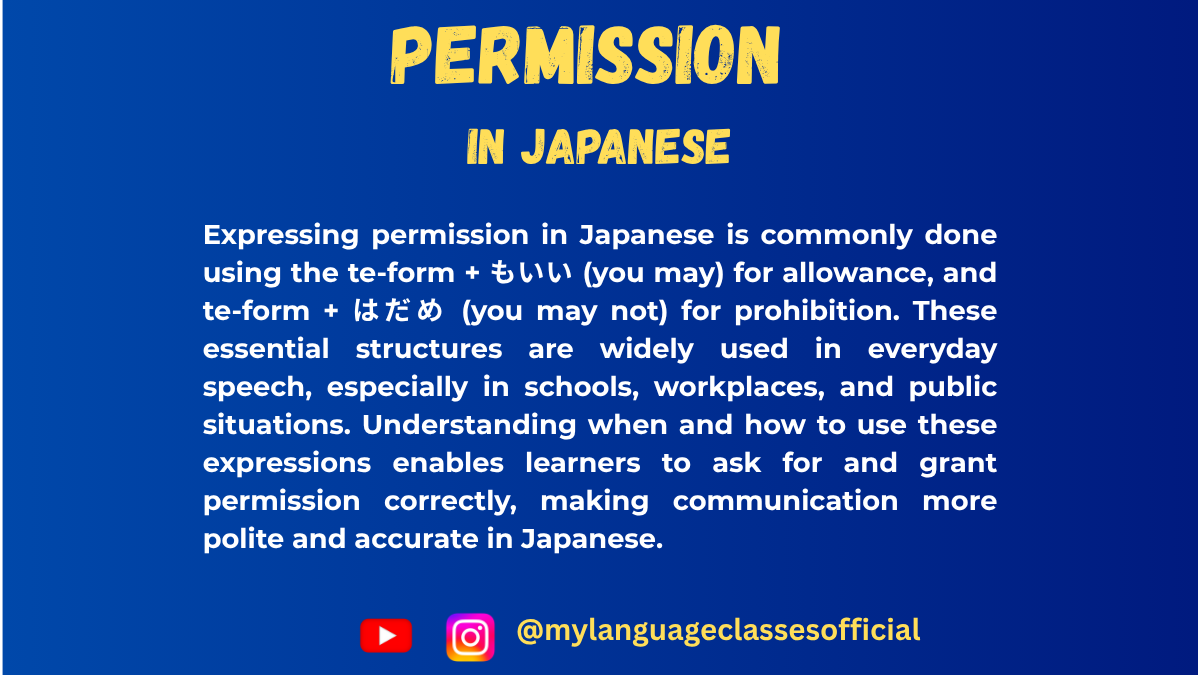Your cart is currently empty!
Category: Japanese – Beginner
Welcome to Japanese – Beginner! 🌸 If you’re new to Japanese, this section is your starting point. Learn hiragana, katakana, and essential vocabulary to get you communicating in Japanese from day one.
In this section, you’ll find:
🔹 Basic grammar such as sentence structure, particles, and verb conjugations
🔹 Essential vocabulary for everyday conversations
🔹 Simple practice exercises and quizzes
🔹 Pronunciation tips for better communication
🔹 Writing practice for hiragana and katakana
Start your journey into the world of Japanese with confidence and excitement!
-
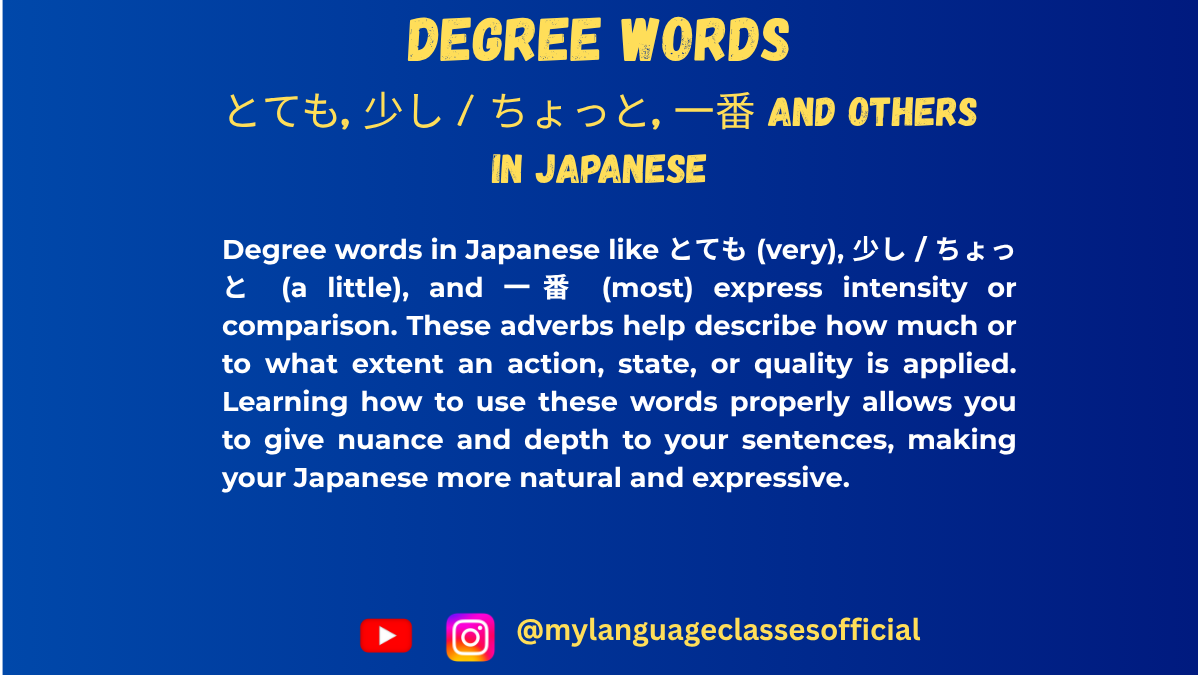
Mastering Degree Words in Japanese
Mastering Degree Expressions in Japanese
Degree expressions in Japanese are essential tools for describing intensity, extent, or degree of an action or quality. They are commonly used in daily conversation and writing, adding nuance and specificity to your expressions. This blog post explores patterns like とても (“very”) and あまり (“not very”) along with other degree expressions, providing details on their usage, nuances, and examples.
1. Basic Degree Expressions
とても (Totemo) – “Very”
- Usage: Used to emphasize a high degree of something.
- Structure:
とても + adjective/adverb
Example:- このケーキはとてもおいしいです。
(Kono kēki wa totemo oishii desu.)
→ This cake is very delicious. - 彼はとても速く走ります。
(Kare wa totemo hayaku hashirimasu.)
→ He runs very fast.
- このケーキはとてもおいしいです。
あまり (Amari) – “Not very” (with negative forms)
- Usage: Indicates a low degree of something and is used with negative forms of verbs or adjectives.
- Structure:
あまり + negative form of adjective/verb
Example:- あの映画はあまりおもしろくなかったです。
(Ano eiga wa amari omoshiroku nakatta desu.)
→ That movie wasn’t very interesting. - 天気はあまり良くありませんでした。
(Tenki wa amari yoku arimasen deshita.)
→ The weather wasn’t very good.
- あの映画はあまりおもしろくなかったです。
2. Other Common Degree Expressions
少し / ちょっと (Sukoshi / Chotto) – “A little”
- Usage: Indicates a small degree or extent. ちょっと is more casual than 少し.
- Structure:
少し/ちょっと + adjective/verb
Example:- 部屋は少し寒いです。
(Heya wa sukoshi samui desu.)
→ The room is a little cold. - ちょっと待ってください。
(Chotto matte kudasai.)
→ Please wait a moment.
- 部屋は少し寒いです。
かなり / 相当 (Kanari / Sōtō) – “Quite/Considerably”
- Usage: Indicates a significant degree, but less than とても.
- Structure:
かなり/相当 + adjective/adverb
Example:- この問題はかなり難しいです。
(Kono mondai wa kanari muzukashii desu.)
→ This problem is quite difficult. - 彼は相当疲れているようです。
(Kare wa sōtō tsukarete iru yō desu.)
→ He seems considerably tired.
- この問題はかなり難しいです。
非常に (Hijō ni) – “Extremely”
- Usage: Formal and strong degree expression, often used in written or formal contexts.
- Structure:
非常に + adjective/adverb
Example:- このテクノロジーは非常に有用です。
(Kono tekunorojī wa hijō ni yūyō desu.)
→ This technology is extremely useful.
- このテクノロジーは非常に有用です。
3. Nuanced Degree Expressions
そんなに (Sonna ni) – “So much” (with negative)
- Usage: Typically used in negative contexts to downplay something.
- Structure:
そんなに + negative form
Example:- この宿題はそんなに難しくありません。
(Kono shukudai wa sonna ni muzukashiku arimasen.)
→ This homework isn’t so difficult.
- この宿題はそんなに難しくありません。
めっちゃ / 超 (Meccha / Chō) – “Super” (Informal)
- Usage: Extremely casual and common in spoken Japanese, especially among younger people.
- Structure:
めっちゃ/超 + adjective
Example:- この店のラーメン、超うまい!
(Kono mise no rāmen, chō umai!)
→ The ramen at this place is super delicious! - 昨日はめっちゃ楽しかった。
(Kinō wa meccha tanoshikatta.)
→ Yesterday was super fun.
- この店のラーメン、超うまい!
4. Expressing Extremes
一番 (Ichiban) – “The most”
- Usage: Indicates the highest degree or rank.
- Structure:
一番 + adjective/adverb
Example:- 富士山は日本で一番高い山です。
(Fujisan wa Nihon de ichiban takai yama desu.)
→ Mount Fuji is the tallest mountain in Japan.
- 富士山は日本で一番高い山です。
最高に (Saikō ni) – “The best/most”
- Usage: Used to express the peak level of a positive quality.
- Structure:
最高に + adjective
Example:- 今日は最高に幸せです。
(Kyō wa saikō ni shiawase desu.)
→ I’m the happiest today.
- 今日は最高に幸せです。
5. Things to Keep in Mind
- Context Matters:
- Use formal expressions like 非常に in professional or academic settings.
- Opt for casual expressions like めっちゃ in informal conversations.
- Politeness Levels:
Adjust your degree expressions depending on who you are speaking to. For instance, avoid めっちゃ with your boss, and use とても or かなり instead. - Avoid Overusing:
Overloading sentences with degree expressions can make your speech sound unnatural. Be selective and intentional. - Negative Nuances:
Expressions like あまり and そんなに are inherently tied to negativity. Ensure you pair them with negative predicates.
6. Practice Makes Perfect
The best way to master degree expressions is through regular practice. Try using these patterns in daily conversation or writing. Listen to native speakers in dramas, anime, or news to observe how these expressions are naturally applied.
By incorporating these degree expressions into your Japanese language practice, you’ll develop a richer and more nuanced ability to communicate, allowing you to better convey your thoughts and feelings. Happy learning!
If you enjoyed this lesson, be sure to check out more posts like this on my blog at My Language Classes. Don’t forget to subscribe my YouTube channel and follow me on Instagram for the latest language learning tips and lessons. Leave a comment below to share your thoughts, or ask any questions you have about nouns.
Happy learning! 😊
📚 Continue Learning Japanese
-
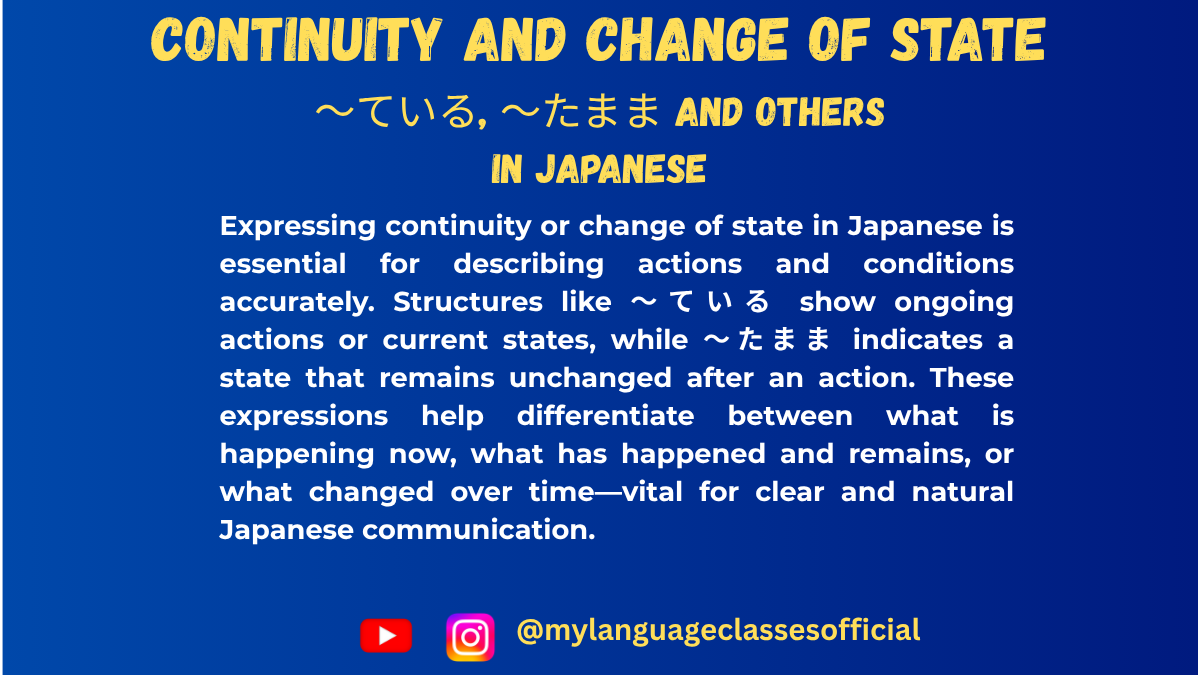
How to Show Continuity in Japanese
Expressing Continuity or Change of State in Japanese
In Japanese, understanding how to express ongoing actions, states, or transitions is essential for achieving fluency. These expressions allow speakers to describe actions in progress, habitual actions, or states resulting from actions. In this blog, we’ll dive into various patterns to express continuity or a change of state, starting with the well-known Verb て-form + いる, and expanding into other structures and nuances.
1. Verb て-form + いる (~ている)
Usage:
- Continuous Action: Indicates an action currently in progress.
- Example:
- 本を読んでいる。
(Hon o yonde iru.)
“I am reading a book.”
- 本を読んでいる。
- Example:
- Resultant State: Refers to the state resulting from an action.
- Example:
- ドアが開いている。
(Doa ga aite iru.)
“The door is open.” (The action of opening has occurred, and the state is ongoing.)
- ドアが開いている。
- Example:
- Habitual Action: Expresses something done regularly or habitually.
- Example:
- 毎朝ジョギングをしている。
(Maiasa jogingu o shite iru.)
“I jog every morning.”
- 毎朝ジョギングをしている。
- Example:
Points to Keep in Mind:
- The context determines whether it refers to an ongoing action, a resultant state, or a habitual action.
- In casual speech, いる is often contracted to る or omitted entirely. For example:
- 読んでる instead of 読んでいる.
2. Verb Stem + 続ける (~つづける)
This pattern expresses the idea of continuing an action without stopping.
Usage:
- Continuous Action: Indicates persistence or continuity of an action.
- Example:
- 彼は勉強し続ける。
(Kare wa benkyou shi tsuzukeru.)
“He continues to study.”
- 彼は勉強し続ける。
- Example:
Points to Keep in Mind:
- The verb 続ける (to continue) can also be conjugated, e.g., 続けます (formal), 続けた (past tense).
- This structure emphasizes effort or intention behind continuity.
3. Verb た-form + まま
This structure expresses the idea of a state being left unchanged.
Usage:
- Unchanged State: Indicates that something remains in its current state.
- Example:
- 靴を履いたまま部屋に入らないでください。
(Kutsu o haita mama heya ni hairanaide kudasai.)
“Please don’t enter the room with your shoes on.”
- 靴を履いたまま部屋に入らないでください。
- Example:
Points to Keep in Mind:
- The subject must remain in the state expressed by the verb.
- Often used to highlight an undesirable or unintended state.
4. Noun + のまま
Similar to the verb usage, this pattern expresses an unchanged state with nouns.
Usage:
- Unchanged State: Describes a situation where something stays the same.
- Example:
- 冷たい飲み物のまま飲んだ。
(Tsumetai nomimono no mama nonda.)
“I drank it while it was still cold.”
- 冷たい飲み物のまま飲んだ。
- Example:
5. Verb Base + ながら
The ~ながら form allows for the expression of two simultaneous actions.
Usage:
- Simultaneous Actions: Describes doing one action while performing another.
- Example:
- 音楽を聴きながら勉強する。
(Ongaku o kikinagara benkyou suru.)
“I study while listening to music.”
- 音楽を聴きながら勉強する。
- Example:
Points to Keep in Mind:
- The main focus is usually on the action described by the main clause.
- Both actions must involve the same subject.
6. Adjective + まま
Describes a state where something remains as it is, often with adjectives.
Usage:
- Unchanged Condition:
- Example:
- 暑いままで寝てしまった。
(Atsui mama de nete shimatta.)
“I fell asleep while it was still hot.”
- 暑いままで寝てしまった。
- Example:
7. Verb て-form + いく / Verb て-form + くる
These forms express a change of state over time or movement.
Usage:
- ~ていく: Indicates a progression away from the present or current state.
- Example:
- 暗くなっていく。
(Kuraku natte iku.)
“It’s getting darker.”
- 暗くなっていく。
- Example:
- ~てくる: Indicates a progression towards the present or a return to the current state.
- Example:
- 涼しくなってきた。
(Suzushiku natte kita.)
“It has started to become cool.”
- 涼しくなってきた。
- Example:
Points to Keep in Mind:
- These forms are particularly useful for describing gradual or dynamic changes.
8. Verb Stem + 出す / Verb Stem + 始める
Both patterns describe the initiation of an action or state.
Usage:
- ~出す: Indicates a sudden or spontaneous beginning of an action.
- Example:
- 赤ちゃんが泣き出した。
(Akachan ga nakidashita.)
“The baby started crying.”
- 赤ちゃんが泣き出した。
- Example:
- ~始める: Describes the commencement of an action.
- Example:
- 本を読み始める。
(Hon o yomihajimeru.)
“I start reading a book.”
- 本を読み始める。
- Example:
Points to Keep in Mind:
- 出す suggests a more abrupt or unexpected start, while 始める implies a deliberate beginning.
Final Thoughts:
When discussing continuity or a change of state in Japanese, understanding the nuances of these patterns is crucial. The choice of expression depends on context, intent, and the subtleties of the situation being described. Here are some key points to remember:
- Context is king: Be mindful of whether you’re describing an ongoing action, a habitual action, or a resultant state.
- Nuance matters: Patterns like ~ていく and ~てくる convey subtle differences in directionality or emotional tone.
- Practice in context: Try creating sentences using each pattern to internalize their meanings and usage.
By mastering these structures, you can convey complex temporal and state-related concepts in Japanese with clarity and precision. Happy learning! 😊
If you enjoyed this lesson, be sure to check out more posts like this on my blog at My Language Classes. Don’t forget to subscribe my YouTube channel and follow me on Instagram for the latest language learning tips and lessons. Leave a comment below to share your thoughts, or ask any questions you have about nouns.
Happy learning! 😊
📚 Continue Learning Japanese
- Continuous Action: Indicates an action currently in progress.
-
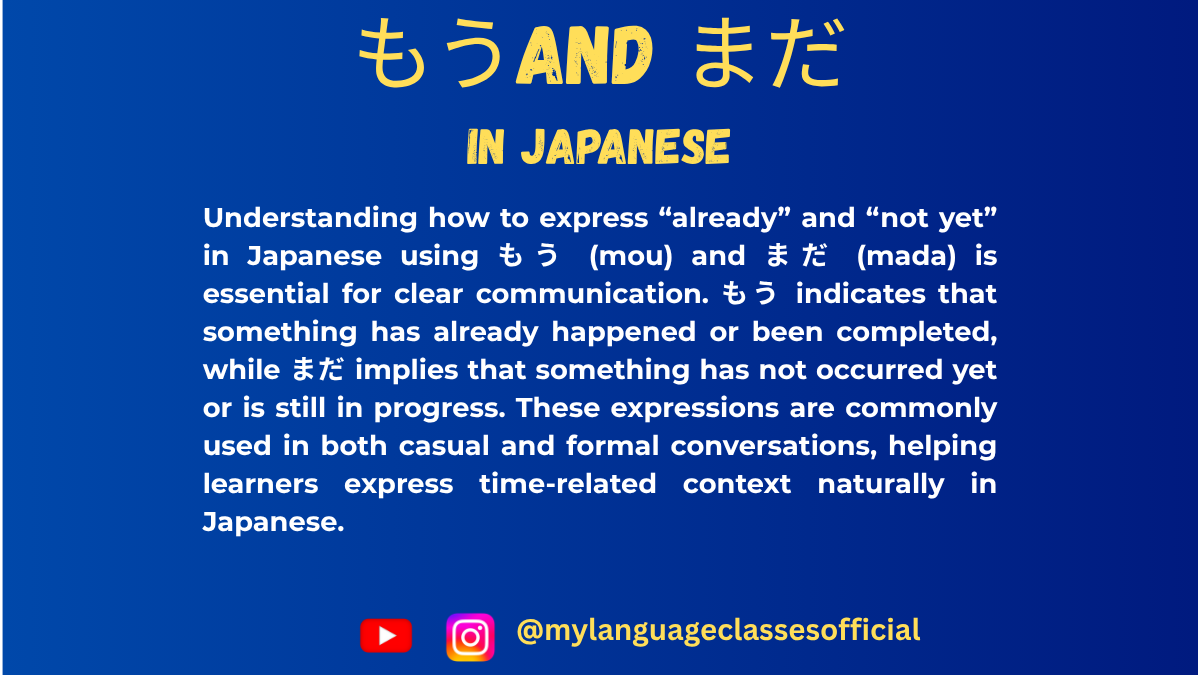
How to Say “Already” and “Not Yet” in Japanese もう and まだ
Expressing “Already” and “Not Yet” in Japanese
When learning Japanese, one of the first challenges is understanding how to express “already” and “not yet.” In English, these concepts are simple, but in Japanese, we rely on two essential words: もう (mou) and まだ (mada). By the end of this post, you’ll master how to use these two expressions correctly and naturally.
1. Understanding もう (“Already”)
The word もう translates to “already” in English and is used to indicate that an action has already been completed or a state has been reached.
Examples of もう in Sentences
- もう食べました。
Mou tabemashita.
“I already ate.” - もう終わりましたか?
Mou owarimashita ka?
“Have you already finished?” - 彼はもう来ました。
Kare wa mou kimashita.
“He has already come.”
Key Point for もう:
- Use it with the past tense of a verb to show completion.
- It often expresses a sense of surprise or confirmation.
2. Understanding まだ (“Not Yet”)
On the other hand, まだ means “not yet” and expresses an action or state that has not happened or is still ongoing.
Examples of まだ in Sentences
- まだ食べていません。
Mada tabete imasen.
“I haven’t eaten yet.” - まだ終わっていない。
Mada owatte inai.
“It’s not finished yet.” - 彼はまだ来ていません。
Kare wa mada kite imasen.
“He hasn’t come yet.”
Key Point for まだ:
- Use it with the negative form of a verb.
- It implies that something is expected to happen or still in progress.
3. Using もう and まだ Together
To create a clear contrast, you can use もう and まだ in conversations:
- もう食べましたか?
Mou tabemashita ka?
“Have you already eaten?”- Answer (Yes): もう食べました。(Mou tabemashita.) – “I already ate.”
- Answer (No): まだ食べていません。(Mada tabete imasen.) – “I haven’t eaten yet.”
This contrast helps clarify whether something has already occurred or is still pending.
4. Common Expressions Using もう and まだ
Here are a few handy expressions that use these words:
- もういいです。 (Mou ii desu.) – “It’s okay now.” / “I’m done.”
- まだまだです。 (Mada mada desu.) – “I still have a long way to go.” (Often used humbly about one’s skills or progress.)
5. Summary: Quick Reference Table
Word Meaning Usage Example もう Already Past/Complete Actions もう行きました。 (Mou ikimashita.) – “I already went.” まだ Not Yet/Still Negative or Ongoing まだ行っていません。 (Mada itte imasen.) – “I haven’t gone yet.”
6. Practice Time!
Try filling in the blanks with もう or まだ:
- ( )宿題を終えましたか? (… shukudai o oemashita ka?)
“Have you finished your homework already?” - いいえ、( )終わっていません。
“No, I haven’t finished yet.”
Answers:
- もう
- まだ
By practicing もう and まだ, you’ll gain confidence in expressing whether something has “already” happened or “not yet.” Keep listening to native speakers and trying these phrases in daily conversation—まだまだ there’s plenty to learn, but you’re already doing great!
What do you think about these tips? Let me know if you もう understand or if you’re まだ unsure—leave a comment below! 😊
If you enjoyed this lesson, be sure to check out more posts like this on my blog at My Language Classes. Don’t forget to subscribe my YouTube channel and follow me on Instagram for the latest language learning tips and lessons. Leave a comment below to share your thoughts, or ask any questions you have about nouns.
Happy learning! 😊
📚 Continue Learning Japanese
- もう食べました。
-
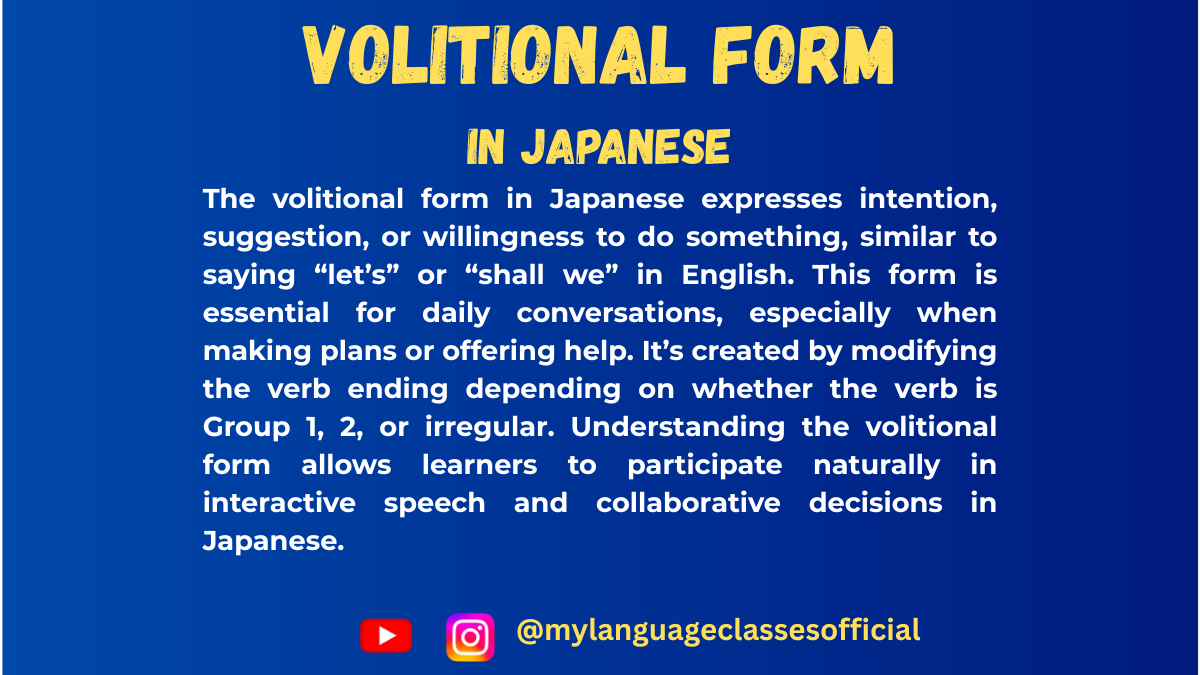
Understanding Volitional Form in Japanese
Volitional Form in Japanese
The volitional form in Japanese is a versatile and essential grammatical structure. It’s often used to express intentions, suggestions, or invitations. Think of it as the Japanese equivalent of saying, “Let’s” or “Shall we?” in English.
This post will break it down into two main categories: the informal volitional form and the polite volitional form, making it easy for learners of all levels to grasp and apply.
1. The Informal Volitional Form
The informal volitional form is used casually among friends, family, or people you’re close to. It’s the shorter, more relaxed version of suggesting something.
How to Form It
The structure depends on whether the verb is a う-verb or a る-verb. Here’s how you can form the volitional form:
- For う-verbs: Replace the final う sound with おう.
- Example:
- 行く (iku – to go) → 行こう (ikou – Let’s go)
- 飲む (nomu – to drink) → 飲もう (nomou – Let’s drink)
- Example:
- For る-verbs: Drop the る and add よう.
- Example:
- 食べる (taberu – to eat) → 食べよう (tabeyou – Let’s eat)
- 見る (miru – to see/watch) → 見よう (miyou – Let’s watch)
- Example:
- Irregular verbs: These don’t follow the usual patterns and need to be memorized:
- する (suru – to do) → しよう (shiyou – Let’s do)
- 来る (kuru – to come) → 来よう (koyou – Let’s come)
When to Use It
Use the informal volitional form in casual contexts:
- Planning something with friends:
- 映画を見よう! (Eiga o miyou! – Let’s watch a movie!)
- Deciding something for yourself:
- もっと頑張ろう。 (Motto ganbarou. – I’ll try harder.)
2. The Polite Volitional Form
For more formal situations, the polite volitional form is used. This is especially common in workplaces, public settings, or when speaking to superiors or strangers.
How to Form It
The polite volitional form follows a straightforward rule:
- Take the stem of the verb and add ましょう.
- Example:
- 行く (iku – to go) → 行きましょう (ikimashou – Let’s go)
- 食べる (taberu – to eat) → 食べましょう (tabemashou – Let’s eat)
When to Use It
Use the polite volitional form in formal or respectful contexts:
- Inviting someone politely:
- 一緒に昼ご飯を食べましょうか? (Issho ni hiru gohan o tabemashou ka? – Shall we have lunch together?)
- Offering a suggestion in a business setting:
- 次のステップを考えましょう。 (Tsugi no suteppu o kangaemashou. – Let’s think about the next step.)
3. Key Differences Between Informal and Polite Forms
Aspect Informal Volitional Form Polite Volitional Form Tone Casual Formal/Respectful Ending おう/よう Verb stem + ましょう Usage Context Friends, family Business, public, formal
4. Practice Makes Perfect!
Here are a few sentences to test your understanding. Try converting them into both informal and polite volitional forms:
- 泳ぐ (oyogu – to swim)
- 話す (hanasu – to talk)
- 勉強する (benkyou suru – to study)
Answers:
- 泳ぐ: 泳ごう / 泳ぎましょう
- 話す: 話そう / 話しましょう
- 勉強する: 勉強しよう / 勉強しましょう
By mastering the volitional form, you’ll be well on your way to expressing intentions and making suggestions naturally in Japanese. Practice using these forms in conversations, and soon they’ll become second nature. 頑張りましょう! (Ganbarimashou! – Let’s do our best!)
If you enjoyed this lesson, be sure to check out more posts like this on my blog at My Language Classes. Don’t forget to subscribe my YouTube channel and follow me on Instagram for the latest language learning tips and lessons. Leave a comment below to share your thoughts, or ask any questions you have about nouns.
Happy learning! 😊
📚 Continue Learning Japanese
- For う-verbs: Replace the final う sound with おう.
-
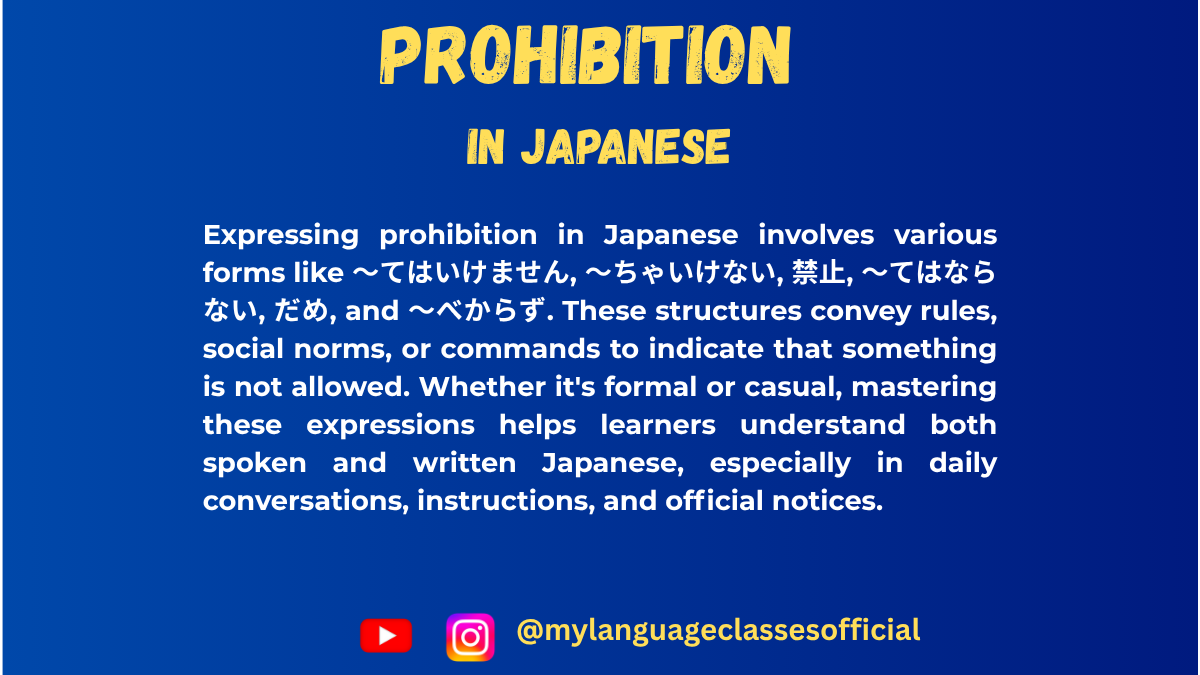
How to Express Prohibition in Japanese
Expressing Prohibition in Japanese
If you’re learning Japanese, mastering how to express prohibition (saying what cannot or should not be done) is an essential step toward fluency. Japanese has a rich tapestry of expressions for prohibition, each carrying different nuances based on politeness levels, context, and the strength of the prohibition. In this blog, I’ll guide you through the most common ways to express prohibition in Japanese and help you understand when to use them.
1. ~てはいけません (Te wa ikemasen)
This is one of the most commonly used and polite ways to express prohibition in Japanese. It translates roughly to “You must not…” or “It’s not allowed to…”.
Formation:
Take the te-form of the verb and attach ~てはいけません.
Example:
- ここでたばこを吸ってはいけません。
(Koko de tabako o sutte wa ikemasen.)
“You must not smoke here.”
This phrase is often used in formal situations, such as school rules, workplace guidelines, or signs in public spaces.
2. ~ちゃダメ / ~ちゃいけない (Casual Forms)
In casual settings, Japanese speakers often use ~ちゃダメ or ~ちゃいけない to express prohibition. These are informal contractions of ~てはいけません.
Example:
- ここでゲームしちゃダメだよ。
(Koko de geemu shicha dame da yo.)
“You can’t play games here.” - あそこで走っちゃいけない。
(Asoko de hashiccha ikenai.)
“You must not run over there.”
Use these with close friends, family members, or peers, but avoid them in formal contexts.
3. 禁止 (Kinshi) – The Formal, Written Prohibition
When expressing prohibition in written form, especially on signs or official notices, the word 禁止 (kinshi, meaning “prohibited”) is frequently used.
Example:
- 飲酒禁止 (Inshu kinshi)
“Drinking alcohol is prohibited.” - 駐車禁止 (Chuusha kinshi)
“No parking.”
This construction is direct and impersonal, commonly used in public spaces to state clear rules.
4. ~てはならない (Te wa naranai)
This is a more formal and literary way of expressing prohibition. It is less common in daily conversation but can be seen in legal documents or formal writings.
Example:
- 嘘をついてはならない。
(Uso o tsuite wa naranai.)
“You must not tell lies.”
5. Use of だめ (Dame)
The word だめ (dame) itself means “no good,” “not allowed,” or “forbidden.” It’s highly versatile and can stand alone as an expression of prohibition.
Examples:
- それはだめです。 (Sore wa dame desu.)
“That’s not allowed.” - 今はだめ。 (Ima wa dame.)
“Not now.”
Depending on the tone and situation, だめ can range from strict to soft and conversational.
6. ~べからず (Bekarazu) – Traditional and Strict
This archaic phrase is rarely used in modern conversation but appears in traditional, formal, or poetic contexts.
Example:
- 立ち入りべからず。
(Tachiiri bekarazu.)
“No trespassing.”
It carries an old-fashioned and authoritative tone, reminiscent of samurai-era language.
Choosing the Right Expression
When deciding how to express prohibition in Japanese, consider the following factors:
- Formality: Use ~てはいけません for polite conversations and signs, and ~ちゃダメ for casual settings.
- Authority: Use 禁止 or ~てはならない for official or serious prohibitions.
- Audience: Adapt your language based on whether you’re speaking to a friend, a stranger, or a group.
Practice Makes Perfect!
Understanding prohibition in Japanese is only the first step; using it naturally requires practice. Try creating your own sentences using these structures, and pay attention to how native speakers use them in real life. The more you immerse yourself, the more intuitive these expressions will become.
So, what are you waiting for? Share your practice sentences in the comments, and let’s refine your skills together!
あなたはどの禁止表現をよく使いますか?コメントで教えてください!
(Anata wa dono kinshi hyougen o yoku tsukaimasu ka? Komento de oshiete kudasai!)
Which prohibition expression do you use most often? Let me know in the comments!
If you enjoyed this lesson, be sure to check out more posts like this on my blog at My Language Classes. Don’t forget to subscribe my YouTube channel and follow me on Instagram for the latest language learning tips and lessons. Leave a comment below to share your thoughts, or ask any questions you have about nouns.
Happy learning! 😊
📚 Continue Learning Japanese
- ここでたばこを吸ってはいけません。
-
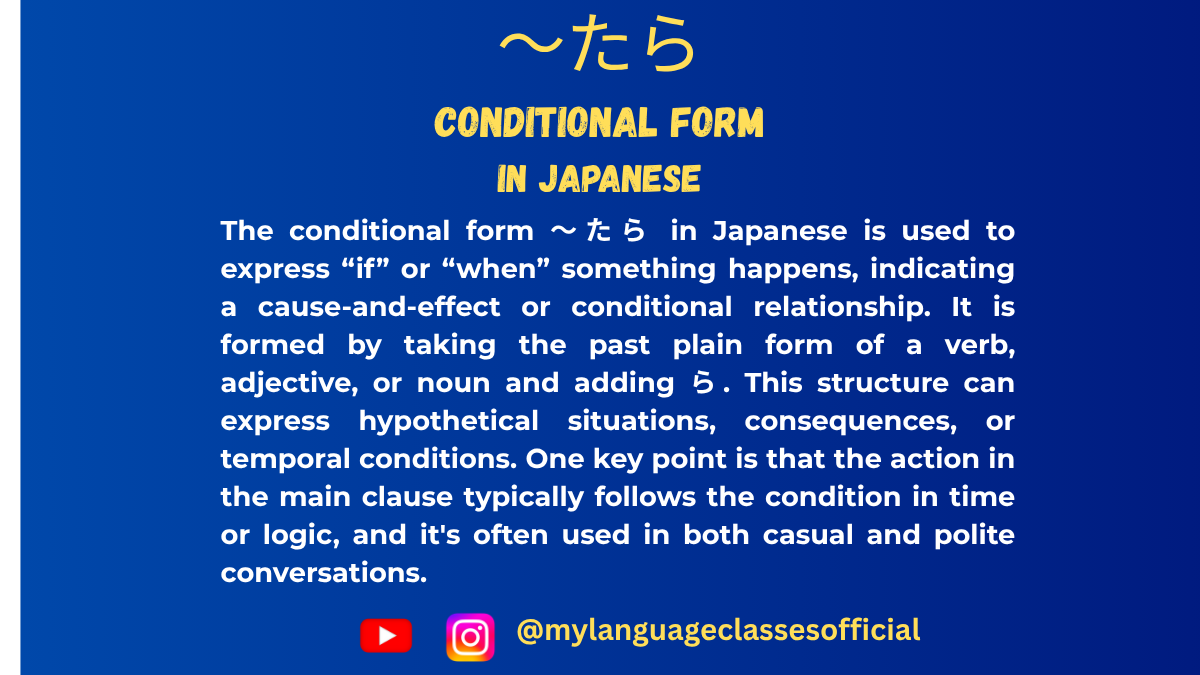
Understanding Conditional form ~たら in Japanese
Understanding ~たら in Japanese
Learning Japanese grammar often feels like solving a puzzle, where each piece contributes to your fluency. One such critical piece is the ~たら structure, a conditional form that translates roughly to “if” or “when” in English. In this blog post, we’ll break down how to use ~たら effectively, covering its structure, usage, and nuances, along with examples to boost your confidence.
What is ~たら?
The ~たら structure comes from the past tense form of a verb, adjective, or noun, combined with ら (ra). It’s used to express conditional situations, which means it helps us talk about “if” or “when” something happens.
Key Functions of ~たら:
- Expressing Conditions: “If X happens, then Y will occur.”
- Temporal Sense: “When X happens, Y will follow.”
This dual meaning is a hallmark of ~たら, and context determines whether it means “if” or “when.”
The Structure of ~たら
Let’s look at how to form ~たら for different word types:
1. Verbs
- Take the plain past tense form (た-form) of the verb + ら.
- Example:
食べる → 食べた → 食べたら (if/when [I] eat)
2. Adjectives
- For い-adjectives, replace the final い with かったら.
- Example: 高い → 高かった → 高かったら (if/when [it’s] expensive)
- For な-adjectives, use the structure: adjective + だったら.
- Example: 静か → 静かだったら (if/when [it’s] quiet)
3. Nouns
- Combine the noun with だったら.
- Example: 休み → 休みだったら (if/when [it’s] a holiday)
Usage Examples
Let’s explore ~たら in action, both as “if” and “when.”
1. Conditional “If”
- 日本に行ったら、寿司を食べたいです。
(Nihon ni ittara, sushi o tabetai desu.)
If I go to Japan, I want to eat sushi. - 時間があったら、映画を見ましょう。
(Jikan ga attara, eiga o mimashou.)
If we have time, let’s watch a movie.
Here, the meaning hinges on a hypothetical condition being met.
2. Temporal “When”
- 家に帰ったら、宿題をします。
(Ie ni kaettara, shukudai o shimasu.)
When I get home, I’ll do my homework. - 雨がやんだら、公園で遊びましょう。
(Ame ga yandara, kouen de asobimashou.)
When the rain stops, let’s play at the park.
In these examples, ~たら conveys a temporal relationship, emphasizing a sequence of events.
Nuances and Tips
- Avoid Overlapping ~たら with ~と or ~ば
While ~と and ~ば also express conditions, ~たら is more versatile because it handles both “if” and “when.” However, ~と is more deterministic (e.g., water boils when heated), and ~ば can feel more formal or speculative. - Expressing Surprise or Discovery
~たら is also used to convey unexpected results:- ドアを開けたら、猫がいました。
(Doa o aketara, neko ga imashita.)
When I opened the door, there was a cat.
Here, the speaker did not anticipate finding a cat.
- ドアを開けたら、猫がいました。
- Avoid Using ~たら for Certainties
If an event is guaranteed to occur (e.g., the sun rising), use a temporal marker like ~時 instead of ~たら.
Practice Time!
Try making your own sentences using ~たら. Here are some prompts to get you started:
- What would you do if you won the lottery?
宝くじに当たったら、______。 - What will you do when the weekend comes?
週末になったら、______。
Share your answers in the comments or with your language partner. Practice makes perfect!
Final Thoughts
The ~たら structure is a cornerstone of Japanese conditional grammar. By mastering it, you’ll unlock the ability to express complex ideas about possibilities and sequences. Remember to pay attention to context to distinguish between “if” and “when,” and don’t hesitate to experiment with it in your conversations.
Ready to elevate your Japanese skills? Try using ~たら today!
If you enjoyed this lesson, be sure to check out more posts like this on my blog at My Language Classes. Don’t forget to subscribe my YouTube channel and follow me on Instagram for the latest language learning tips and lessons. Leave a comment below to share your thoughts, or ask any questions you have about nouns.
Happy learning! 😊
📚 Continue Learning Japanese
-
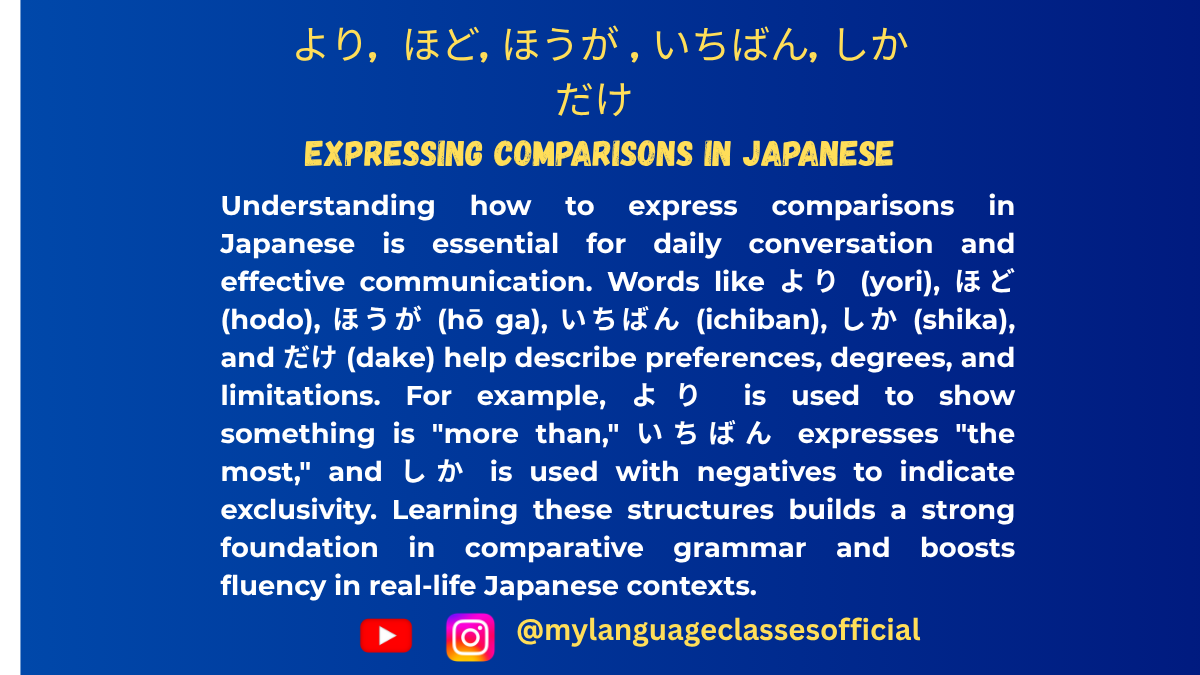
Mastering Comparisons in Japanese より, ほど, ほうが, いちばん, しか, and だけ
Expressing Comparisons in Japanese より, ほど, ほうが, いちばん, しか, and だけ
When learning Japanese, one of the most important concepts is mastering the art of comparisons. Whether you’re talking about how something is “better” or “more” than something else, or simply stating your preference, knowing how to compare effectively helps you express yourself clearly and confidently. In this post, we’ll cover some of the most essential comparison structures in Japanese: より (more than), ほど (more than / to the extent of), ほうが (preference), いちばん (the most), and dive into important distinctions such as より vs ほど and だけ vs しか.
1. より (More Than)
The particle より is used when comparing two items, indicating that one is more than the other. It’s the most straightforward way to show superiority or difference between two things.
Example:
- この映画はあの映画より面白いです。
Kono eiga wa ano eiga yori omoshiroi desu.
This movie is more interesting than that movie.
Here, より is used to compare the two movies, with the first one being more interesting than the second.
2. ほど (More Than / To the Extent of)
ほど is used to express a comparison where something is “more than” another thing, but with a focus on degree or extent. It’s often used when talking about how much more of something there is, especially in terms of actions or abilities.
Example:
- 彼は私ほど速く走れません。
Kare wa watashi hodo hayaku hashiremasen.
He can’t run as fast as I can.
Here, ほど is used to emphasize the difference in the degree of speed. It’s not just “more than” in quantity, but more in terms of ability or extent.
3. より vs ほど (Key Difference)
While both より and ほど can be translated as “more than,” the distinction lies in their nuance:
- より is used for simple comparisons, where one thing is greater or superior than another in a more straightforward sense.
- ほど is used when discussing the degree or extent of a comparison, often involving abilities, qualities, or actions. It can also suggest “to the extent that” or “as much as.”
Example:
- 彼は私より背が高いです。
Kare wa watashi yori se ga takai desu.
He is taller than I am.
(Simple comparison) - 彼は私ほど速く走れません。
Kare wa watashi hodo hayaku hashiremasen.
He can’t run as fast as I can.
(Degree of ability comparison)
4. ほうが (Preference)
The structure ほうが is used to express preference between two things, indicating that one thing is favored over the other.
Example:
- 日本の映画はアメリカの映画より面白いほうが好きです。
Nihon no eiga wa Amerika no eiga yori omoshiroi hō ga suki desu.
I prefer Japanese movies over American movies because they are more interesting.
In this sentence, ほうが emphasizes the preference for Japanese movies compared to American movies.
5. いちばん (The Most)
いちばん is used to indicate the highest degree of something, meaning “the most” or “the best.” It’s used when something stands out as the most in a particular category.
Example:
- 彼女はクラスでいちばんかわいいです。
Kanojo wa kurasu de ichiban kawaii desu.
She is the most beautiful in the class.
Here, いちばん is used to express that she is the top or number one in terms of beauty.
6. だけ (Only) vs しか (Only, but Negative)
Another pair worth noting in comparisons is だけ and しか. Both can be translated as “only,” but the way they are used is quite different.
- だけ is used to indicate a positive statement or simple limitation.Example:
- このレストランには寿司だけがあります。
Kono resutoran ni wa sushi dake ga arimasu.
This restaurant only has sushi.
- このレストランには寿司だけがあります。
- しか is used with a negative verb, indicating “only” but with the sense that there is nothing more than that (often implying something less than expected).Example:
- このレストランには寿司しかありません。
Kono resutoran ni wa sushi shika arimasen.
This restaurant only has sushi (and nothing else).
- このレストランには寿司しかありません。
Notice that with しか, a negative verb is required, while with だけ, the statement can be positive.
Tips for Mastering Comparisons
- Understand the Context: Pay attention to whether you’re making a straightforward comparison or discussing degrees of difference. This will help you choose between より and ほど.
- Practice with Real-Life Examples: Try comparing things you see around you. For example, compare two foods, two movies, or two places. This helps you internalize comparison structures.
- Use ほうが for Preferences: If you’re ever unsure about how to express a preference, use ほうが. It’s a simple way to show that you favor one thing over another.
- Avoid Overcomplicating Things: Don’t worry about using every comparison structure at once. Focus on mastering one at a time—start with より and いちばん, then gradually incorporate ほど and ほうが into your conversations.
- Listen to Native Speakers: Pay attention to how native speakers make comparisons. Listening to their natural flow will help you understand which structure to use in various situations.
Final Thoughts: Mastering Comparisons for Fluent Communication
Mastering comparisons in Japanese is a crucial step toward fluency. By understanding how to use より (more than), ほど (more than / to the extent of), ほうが (preference), and いちばん (the most), you’ll be able to express differences, preferences, and extremes with precision and confidence.
Remember that the key to becoming proficient in any aspect of a language is practice. The more you engage with these comparison structures in your speaking and writing, the more natural they will feel.
So, keep practicing, stay curious, and challenge yourself to use comparisons in your everyday conversations. With continued effort and attention to detail, you’ll be able to navigate the nuances of Japanese comparisons and speak like a native speaker in no time. Happy learning!
If you enjoyed this lesson, be sure to check out more posts like this on my blog at My Language Classes. Don’t forget to subscribe my YouTube channel and follow me on Instagram for the latest language learning tips and lessons. Leave a comment below to share your thoughts, or ask any questions you have about nouns.
Happy learning! 😊
📚 Continue Learning Japanese
- この映画はあの映画より面白いです。
-
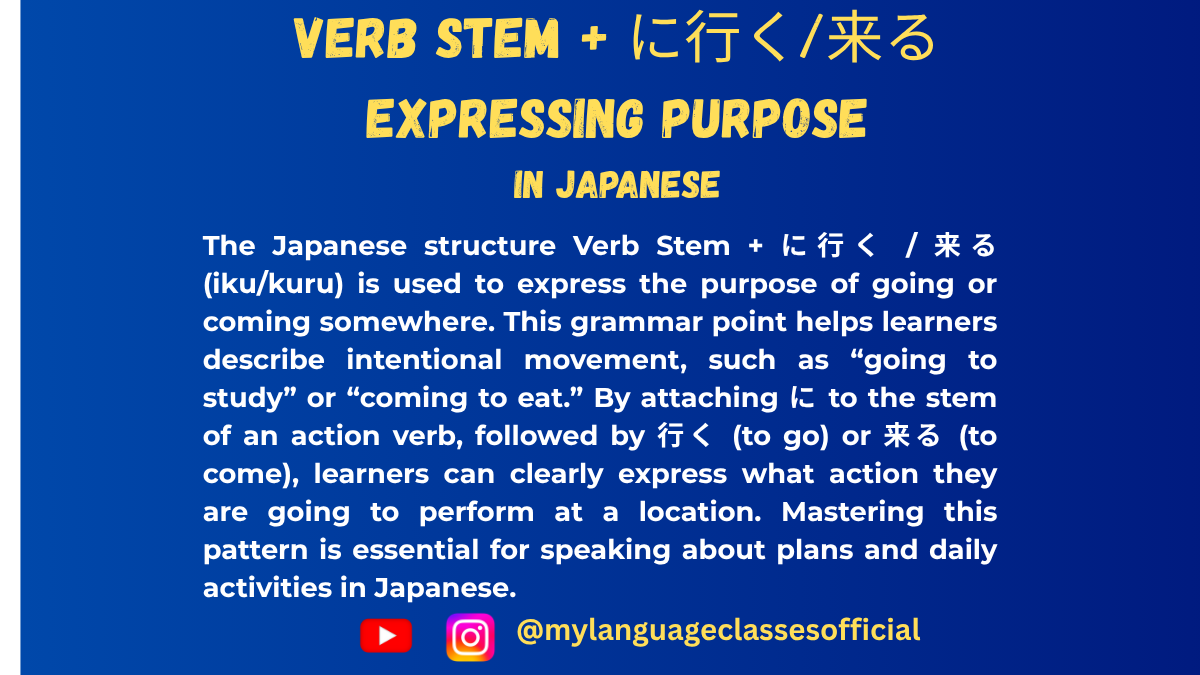
How to Express Purpose in Japanese Verb Stem + に行く / 来る (iku/kuru)
How to Express Purpose in Japanese: The Structure “Verb Stem + に行く/来る
When learning Japanese, one of the key steps toward fluency is understanding how to express purpose. Today, we’ll focus on a practical and widely used grammatical structure: Verb Stem + に行く/来る. This structure is an essential tool for expressing why someone is going somewhere or has come to a specific place.
The Basics: What Does It Mean?
In English, we often say things like, “I go to the park to exercise” or “She comes to the café to study.” In Japanese, you can convey this idea using the Verb Stem + に行く/来る pattern. Here’s how it breaks down:
- Verb Stem: The base form of the verb without its conjugative endings (e.g., ます or る).
- に: A particle indicating the purpose.
- 行く (いく): “To go.”
- 来る (くる): “To come.”
Building the Structure
To form sentences using this structure, follow these steps:
- Start with the stem of the verb that represents the action or purpose.
- Add the particle に.
- End with 行く (if the subject is going to a place) or 来る (if the subject is coming to a place).
Examples:
- To go to eat sushi
→ 寿司を食べに行く
(すしをたべにいく) - To come to study
→ 勉強しに来る
(べんきょうしにくる) - To go to shop
→ 買い物しに行く
(かいものしにいく)
Key Points to Remember
- Focus on the Verb Stem
The “stem” is the form you get when you remove ます from a polite verb or drop the ending る from plain る-verbs.- Example:
食べます → 食べ (stem)
飲む → 飲み (stem)
- Example:
- Particle に
The に particle acts as a marker that connects the purpose to the destination. - Directional Verbs
- 行く implies movement toward a place.
- 来る implies movement toward the speaker’s current location.
- Negative and Past Forms
Like most verbs in Japanese, 行く and 来る can be conjugated.- Negative:
寿司を食べに行かない (I won’t go to eat sushi.) - Past:
勉強しに来た (I came to study.)
- Negative:
Polite and Casual Speech
When speaking with friends, you might use the plain forms 行く and 来る. However, in formal or polite contexts, switch to 行きます and 来ます.
- Polite:
図書館に勉強しに行きます。
(としょかんにべんきょうしにいきます)
“I will go to the library to study.” - Casual:
図書館に勉強しに行く。
(としょかんにべんきょうしにいく)
“I’m going to the library to study.”
Common Mistakes
- Forgetting the Verb Stem
A common error is using the dictionary form instead of the stem. For example:
❌ 食べるに行く
✅ 食べに行く - Mixing Directional Verbs
Be careful to choose 行く or 来る based on the context of movement relative to the speaker.
Practice Makes Perfect
To master this structure, try creating sentences based on your daily activities. For example:
- I will go to the market to buy vegetables.
→ 市場に野菜を買いに行きます。
(いちばにやさいをかいにいきます) - They came to the park to jog.
→ 彼らは公園にジョギングしに来ました。
(かれらはこうえんにジョギングしにきました)
Final Thoughts
The Verb Stem + に行く/来る structure is a powerful and flexible tool for expressing purpose in Japanese. Whether you’re a beginner or advancing in your studies, mastering this form will add clarity and fluency to your communication.
What activity will you use this structure to describe today? Share your example in the comments, and let’s learn together!
If you enjoyed this lesson, be sure to check out more posts like this on my blog at My Language Classes. Don’t forget to subscribe my YouTube channel and follow me on Instagram for the latest language learning tips and lessons. Leave a comment below to share your thoughts, or ask any questions you have about nouns.
Happy learning! 😊
📚 Continue Learning Japanese

